Local Influence of Surface Relative Humidity on Weather Radar Rainfall Observations over an Agricultural Semi-Arid Area
Abstract
1. Introduction
2. Materials and Methods
2.1. Region of Study
2.2. Datasets
2.2.1. Surface Automatic Weather Stations
2.2.2. C-Band Weather Radar Data
2.3. Precipitation Events
2.4. Statistical Methods
3. Results
3.1. Seasonal Cycles Overview
3.2. RH Distribution
3.3. Impact of Precipitation Onset
3.4. Vertical Profiles of Reflectivity
3.5. Z and ΔZ, RH Relation
4. Discussion
5. Conclusions
- Clear seasonal cycles of irrigation influence on RH and mixing ratio (w) during the summer season are found, with both RH and w significantly higher in irrigated areas.
- In summer, when irrigation is most important, the difference in maximum temperatures is not statistically significant, unlike the rest of the year when the climatological regional zonal thermal trend (with increasing temperatures from east to west) dominates. Therefore, irrigation tends to smooth the climatological thermal difference between the two areas.
- Differences in precipitation amounts and 30 min average rainfall between the irrigated and non-irrigated areas are not significant in any season, using either rain gauge data or weather radar estimates. The irrigation impact on these precipitation variables is thus negligible.
- The distribution of RH differences between irrigated and non-irrigated areas is highly variable, and there is not necessarily higher humidity in the irrigated area.
- The onset of rainfall quickly modifies previous conditions of RH, w, and temperature. Examining only the 2 h period before rainfall and the next 30 min period, the RH increases 26%, w increases 10%, and the temperature decreases 10%.
- No relationship is found in the radar reflectivity difference ΔZ between the two lowest CAPPI levels (2 km and 1 km) and RH for neither convective nor stratiform rainfall.
- A linear relationship is detected between the summer convective rainfall reflectivity at the lowest CAPPI level and RH (median slope of 0.10 [dBZ]/[%]) during the first 30 min of rainfall. Note that this result does not imply an effect of irrigation on precipitation but an effect of the low-level moisture.
Author Contributions
Funding
Data Availability Statement
Acknowledgments
Conflicts of Interest
Appendix A
| Parameter [Units] | Description | Value |
|---|---|---|
| Zth [dBZ] | Reflectivity threshold at or above which echoes are classified as convective | 30 |
| Rbg [km] | Radius within which background reflectivity is computed | 5 |
| a [dBZ] | Factor for comparing echo to background reflectivity; see Equation (1) in [34] | 20 |
| b [dBZ] | see Equation (1) in [34] | 40 |
| Rconv [km] | Maximum radius around convective core for possible uncertain classification | 5 |
| Zconv [dBZ] | Minimum dBZ required for Rconv to apply | 40 |
| Zweak [dBZ] | Minimum dBZ for classification as not weak echo | 5 |
| Zshallow [dBZ] | Minimum dBZ for classification as convective for objects with area less than Amed | 10 |
| Alow [km2] | Minimum areal coverage of echo object for classification as convective or stratiform | 8 |
| Amed [km2] | Maximum areal coverage of echo object for allowing Znewth = Zshallow | 8 |
| Ahigh [km2] | Minimum areal coverage of echo object for assigning Znewth = Zth | 10 |
Appendix B
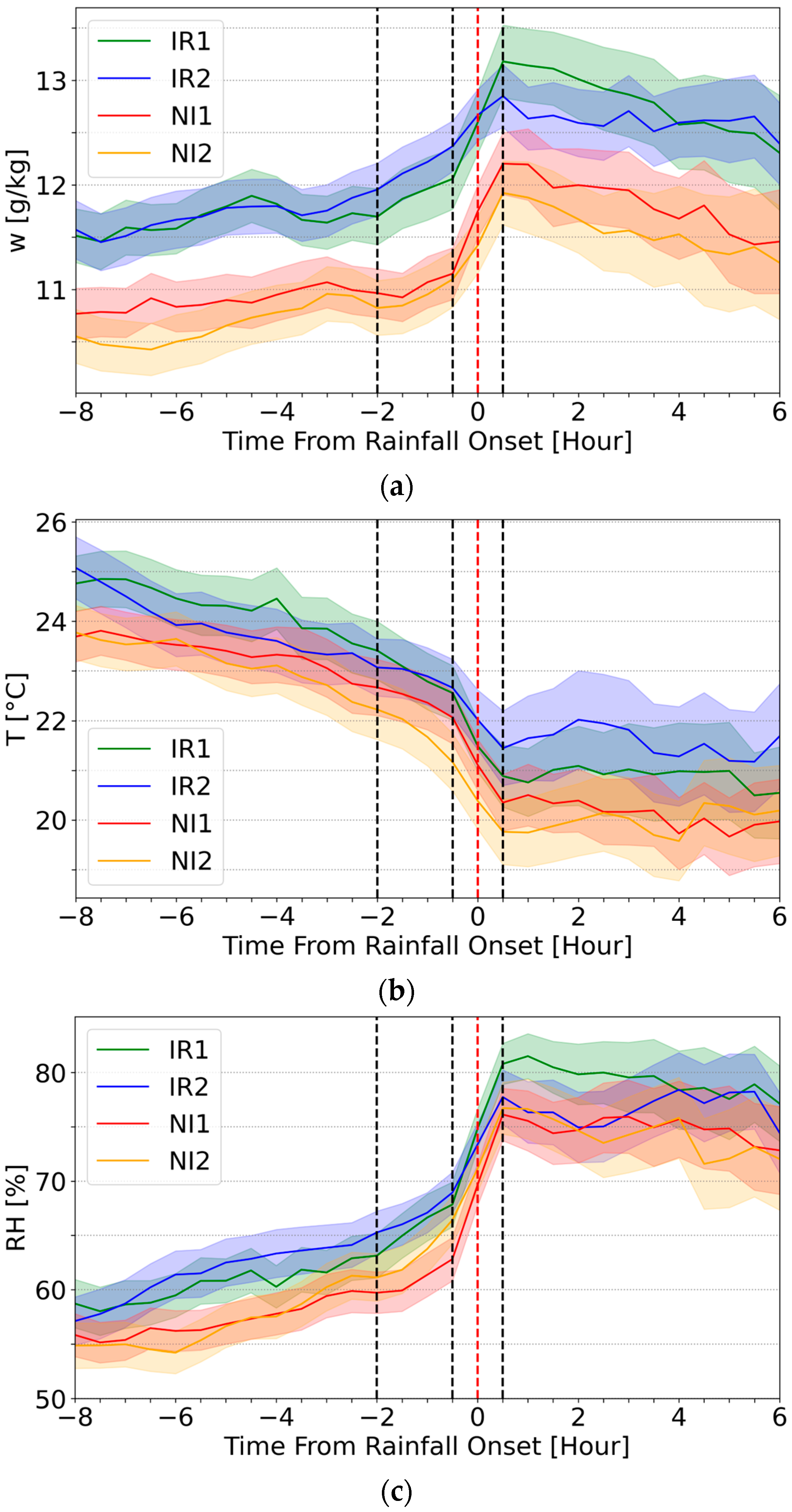
References
- Pielke, S. Influence of the Spatial Distribution of Vegetation and Soils on the Prediction of Cumulus Convective Rainfall. Rev. Geophys. 2001, 39, 151–177. [Google Scholar] [CrossRef]
- McDermid, S.; Nocco, M.; Lawston-Parker, P.; Keune, J.; Pokhrel, Y.; Jain, M.; Jägermeyr, J.; Brocca, L.; Massari, C.; Jones, A.D.; et al. Irrigation in the Earth System. Nat. Rev. Earth Environ. 2023, 4, 435–453. [Google Scholar] [CrossRef]
- Brooke, J.K.; Best, M.J.; Lock, A.P.; Osborne, S.R.; Price, J.; Cuxart, J.; Boone, A.; Canut-Rocafort, G.; Hartogensis, O.K.; Roy, A. Irrigation Contrasts through the Morning Transition. Q. J. R. Meteorol. Soc. 2024, 150, 170–194. [Google Scholar] [CrossRef]
- Boone, A.; Bellvert, J.; Best, M.; Brooke, J.K.; Canut-Rocafort, G.; Cuxart, J.; Hartogensis, O.; Le Moigne, P.; Miró, J.R.; Polcher, J.; et al. The Land Surface Interactions with the Atmosphere over the Iberian Semi-Arid Environment (LIAISE) Field Campaign. J. Eur. Meteorol. Soc. 2025, 2, 100007. [Google Scholar] [CrossRef]
- Koster, R.D.; Suarez, M.J.; Higgins, R.W.; Van den Dool, H.M. Observational Evidence That Soil Moisture Variations Affect Precipitation. Geophys. Res. Lett. 2003, 30, 1241. [Google Scholar] [CrossRef]
- Douglas, E.M.; Beltrán-Przekurat, A.; Niyogi, D.; Pielke, R.A.; Vörösmarty, C.J. The Impact of Agricultural Intensification and Irrigation on Land-Atmosphere Interactions and Indian Monsoon Precipitation—A Mesoscale Modeling Perspective. Glob. Planet. Chang. 2009, 67, 117–128. [Google Scholar] [CrossRef]
- Findell, K.L.; Gentine, P.; Lintner, B.R.; Kerr, C. Probability of Afternoon Precipitation in Eastern United States and Mexico Enhanced by High Evaporation. Nat. Geosci. 2011, 4, 434–439. [Google Scholar] [CrossRef]
- Taylor, C.M.; De Jeu, R.A.M.; Guichard, F.; Harris, P.P.; Dorigo, W.A. Afternoon Rain More Likely over Drier Soils. Nature 2012, 489, 423–426. [Google Scholar] [CrossRef] [PubMed]
- Guillod, B.P.; Orlowsky, B.; Miralles, D.G.; Teuling, A.J.; Seneviratne, S.I. Reconciling Spatial and Temporal Soil Moisture Effects on Afternoon Rainfall. Nat. Commun. 2015, 6, 6443. [Google Scholar] [CrossRef] [PubMed]
- Douglas, E.M.; Niyogi, D.; Frolking, S.; Yeluripati, J.B.; Pielke, R.A.; Niyogi, N.; Vörösmarty, C.J.; Mohanty, U.C. Changes in Moisture and Energy Fluxes Due to Agricultural Land Use and Irrigation in the Indian Monsoon Belt. Geophys. Res. Lett. 2006, 33, L14403. [Google Scholar] [CrossRef]
- Liu, C.; Zipser, E.J. Why Does Radar Reflectivity Tend to Increase Downward toward the Ocean Surface, but Decrease Downward toward the Land Surface? J. Geophys. Res. Atmos. 2013, 118, 135–148. [Google Scholar] [CrossRef]
- Xie, X.; Evaristo, R.; Troemel, S.; Saavedra, P.; Simmer, C.; Ryzhkov, A. Radar Observation of Evaporation and Implications for Quantitative Precipitation and Cooling Rate Estimation. J. Atmos. Ocean. Technol. 2016, 33, 1779–1792. [Google Scholar] [CrossRef]
- Kumjian, M.R.; Prat, O.P.; Reimel, K.J.; van Lier-Walqui, M.; Morrison, H.C. Dual-Polarization Radar Fingerprints of Precipitation Physics: A Review. Remote Sens. 2022, 14, 3706. [Google Scholar] [CrossRef]
- Song, Y.; Han, D.; Zhang, J. Radar and Rain Gauge Rainfall Discrepancies Driven by Changes in Atmospheric Conditions. Geophys. Res. Lett. 2017, 44, 7303–7309. [Google Scholar] [CrossRef]
- Dai, Q.; Yang, Q.; Han, D.; Rico-Ramirez, M.A.; Zhang, S. Adjustment of Radar-Gauge Rainfall Discrepancy Due to Raindrop Drift and Evaporation Using the Weather Research and Forecasting Model and Dual-Polarization Radar. Water Resour. Res. 2019, 55, 9211–9233. [Google Scholar] [CrossRef]
- Boone, A.; Best, M.; Cuxart, J.; Polcher, J.; Quintana, P.; Bellvert, J.; Brooke, J.; Canut-Rocafort, G.; Price, J. Land Surface Interactions with the Atmosphere over the Iberian Semi-Arid Environment (LIAISE). GEWEX News 2019, 29, 8–10. [Google Scholar] [CrossRef]
- Peel, M.C.; Finlayson, B.L.; McMahon, T.A. Updated World Map of the Köppen-Geiger Climate Classification. Hydrol. Earth Syst. Sci. 2007, 11, 1633–1644. [Google Scholar] [CrossRef]
- Peinó, E.; Bech, J.; Polls, F.; Udina, M.; Petracca, M.; Adirosi, E.; Gonzalez, S.; Boudevillain, B. Validation of GPM DPR Rainfall and Drop Size Distributions Using Disdrometer Observations in the Western Mediterranean. Remote Sens. 2024, 16, 2594. [Google Scholar] [CrossRef]
- Agència Estatal de Meteorologia—AEMET, Standard Climate Values. Available online: https://www.aemet.es/en/serviciosclimaticos/datosclimatologicos/valoresclimatologicos (accessed on 12 October 2024).
- Bech, J.; Arús, J.; Castán, S.; Pineda, N.; Rigo, T.; Montanyà, J.; van der Velde, O. A Study of the 21 March 2012 Tornadic Quasi Linear Convective System in Catalonia. Atmos. Res. 2015, 158–159, 192–209. [Google Scholar] [CrossRef]
- Navarro, A.; García-Ortega, E.; Merino, A.; Sánchez, J.L. Extreme Events of Precipitation over Complex Terrain Derived from Satellite Data for Climate Applications: An Evaluation of the Southern Slopes of the Pyrenees. Remote Sens. 2020, 12, 2171. [Google Scholar] [CrossRef]
- Gonzalez, S.; Callado, A.; Werner, E.; Escribà, P.; Bech, J. Coastally Trapped Disturbances Caused by the Tramontane Wind on the Northwestern Mediterranean: Numerical Study and Sensitivity to Short-Wave Radiation. Q. J. R. Meteorol. Soc. 2018, 144, 1321–1336. [Google Scholar] [CrossRef]
- Lunel, T.; Jimenez, M.A.; Cuxart, J.; Martinez-Villagrasa, D.; Boone, A.; Le Moigne, P. The Marinada Fall Wind in the Eastern Ebro Sub-Basin: Physical Mechanisms and Role of the Sea, Orography and Irrigation. Atmos. Chem. Phys. 2024, 24, 7637–7666. [Google Scholar] [CrossRef]
- Dari, J.; Brocca, L.; Modanesi, S.; Massari, C.; Tarpanelli, A.; Barbetta, S.; Quast, R.; Vreugdenhil, M.; Freeman, V.; Barella-Ortiz, A.; et al. Regional Data Sets of High-Resolution (1 and 6 Km) Irrigation Estimates from Space. Earth Syst. Sci. Data 2023, 15, 1555–1575. [Google Scholar] [CrossRef]
- Mangan, M.R.; Hartogensis, O.; Boone, A.; Branch, O.; Canut, G.; Cuxart, J.; de Boer, H.J.; Le Page, M.; Martínez-Villagrasa, D.; Miró, J.R.; et al. The Surface-Boundary Layer Connection across Spatial Scales of Irrigation-Driven Thermal Heterogeneity: An Integrated Data and Modeling Study of the LIAISE Field Campaign. Agric. For. Meteorol. 2023, 335, 109452. [Google Scholar] [CrossRef]
- Udina, M.; Peinó, E.; Polls, F.; Mercader, J.; Guerrero, I.; Valmassoi, A.; Paci, A.; Bech, J. Irrigation Impact on Boundary Layer and Precipitation Characteristics in Weather Research and Forecasting Model Simulations during LIAISE-2021. Q. J. R. Meteorol. Soc. 2024, 150, 3201–3873. [Google Scholar] [CrossRef]
- Llabrés-Brustenga, A.; Rius, A.; Rodríguez-Solà, R.; Casas-Castillo, M.C.; Redaño, A. Quality Control Process of the Daily Rainfall Series Available in Catalonia from 1855 to the Present. Theor. Appl. Climatol. 2019, 137, 2715–2729. [Google Scholar] [CrossRef]
- Prohom, M.; Domonkos, P.; Cunillera, J.; Barrera-Escoda, A.; Busto, M.; Herrero-Anaya, M.; Aparicio, A.; Reynés, J. CADTEP: A New Daily Quality-controlled and Homogenized Climate Database for Catalonia (1950–2021). Int. J. Climatol. 2023, 43, 4771–4789. [Google Scholar] [CrossRef]
- Petty, G.W. A First Course in Atmospheric Thermodynamics; Sundog Publishing: Madison, WI, USA, 2008; ISBN 978-0-9729033-2-5. [Google Scholar]
- Atencia, A.; Mediero, L.; Llasat, M.C.; Garrote, L. Effect of Radar Rainfall Time Resolution on the Predictive Capability of a Distributed Hydrologic Model. Hydrol. Earth Syst. Sci. 2011, 15, 3809–3827. [Google Scholar] [CrossRef]
- Altube, P.; Bech, J.; Argemí, O.; Rigo, T.; Pineda, N. Intercomparison and Potential Synergies of Three Methods for Weather Radar Antenna Pointing Assessment. J. Atmos. Ocean. Technol. 2016, 33, 331–343. [Google Scholar] [CrossRef]
- Fabry, F. Radar Meteorology: Principles and Practice; Cambridge University Press: Cambridge, UK, 2015; ISBN 978-1-108-46039-2. [Google Scholar]
- Rigo, T.; Llasat, M.C.; Esbrí, L. The Results of Applying Different Methodologies to 10 Years of Quantitative Precipitation Estimation in Catalonia Using Weather Radar. Geomatics 2021, 1, 347–368. [Google Scholar] [CrossRef]
- Powell, S.W.; Houze, R.A.; Brodzik, S.R. Rainfall-Type Categorization of Radar Echoes Using Polar Coordinate Reflectivity Data. J. Atmos. Ocean. Technol. 2016, 33, 523–538. [Google Scholar] [CrossRef]
- Cerro, C.; Codina, B.; Bech, J.; Lorente, J. Modeling Raindrop Size Distribution and Z (R) Relations in the Western Mediterranean Area. J. Appl. Meteorol. 1997, 36, 1470–1479. [Google Scholar] [CrossRef]
- Schleiss, M.; Olsson, J.; Berg, P.; Niemi, T.; Kokkonen, T.; Thorndahl, S.; Nielsen, R.; Ellerbæk Nielsen, J.; Bozhinova, D.; Pulkkinen, S. The Accuracy of Weather Radar in Heavy Rain: A Comparative Study for Denmark, the Netherlands, Finland and Sweden. Hydrol. Earth Syst. Sci. 2020, 24, 3157–3188. [Google Scholar] [CrossRef]
- Craciun, C.; Catrina, O. An Objective Approach for Comparing Radar Estimated and Rain Gauge Measured Precipitation. Meteorol. Appl. 2016, 23, 683–690. [Google Scholar] [CrossRef]
- Di Curzio, D.; Di Giovanni, A.; Lidori, R.; Montopoli, M.; Rusi, S. Comparing Rain Gauge and Weather RaDAR Data in the Estimation of the Pluviometric Inflow from the Apennine Ridge to the Adriatic Coast (Abruzzo Region, Central Italy). Hydrology 2022, 9, 225. [Google Scholar] [CrossRef]
- Trapero, L.; Bech, J.; Rigo, T.; Pineda, N.; Forcadell, D. Uncertainty of Precipitation Estimates in Convective Events by the Meteorological Service of Catalonia Radar Network. Atmos. Res. 2009, 93, 408–418. [Google Scholar] [CrossRef]
- Crisologo, I.; Warren, R.A.; Mühlbauer, K.; Heistermann, M. Enhancing the Consistency of Spaceborne and Ground-Based Radar Comparisons by Using Beam Blockage Fraction as a Quality Filter. Atmos. Meas. Tech. 2018, 11, 5223–5236. [Google Scholar] [CrossRef]
- Dunkerley, D. Identifying Individual Rain Events from Pluviograph Records: A Review with Analysis of Data from an Australian Dryland Site. Hydrol. Process. 2008, 22, 5024–5036. [Google Scholar] [CrossRef]
- Pérez Bello, A.; Mailhot, A.; Paquin, D.; Paquin-Ricard, D. Temperature-Precipitation Scaling Rates: A Rainfall Event-Based Perspective. J. Geophys. Res. Atmos. 2022, 127, e2022JD037873. [Google Scholar] [CrossRef]
- Grazzini, F.; Craig, G.C.; Keil, C.; Antolini, G.; Pavan, V. Extreme Precipitation Events over Northern Italy. Part I: A Systematic Classification with Machine-Learning Techniques. Q. J. R. Meteorol. Soc. 2020, 146, 69–85. [Google Scholar] [CrossRef]
- Kopp, J.; Rivoire, P.; Ali, S.M.; Barton, Y.; Martius, O. A Novel Method to Identify Sub-Seasonal Clustering Episodes of Extreme Precipitation Events and Their Contributions to Large Accumulation Periods. Hydrol. Earth Syst. Sci. 2021, 25, 5153–5174. [Google Scholar] [CrossRef]
- Woolson, R.F. Wilcoxon Signed-Rank Test. In Wiley Encyclopedia of Clinical Trials; John Wiley & Sons, Ltd.: Hoboken, NJ, USA, 2008; pp. 1–3. [Google Scholar] [CrossRef]
- Singh, M.S.; Warren, R.A.; Jakob, C. A Steady-State Model for the Relationship Between Humidity, Instability, and Precipitation in the Tropics. J. Adv. Model. Earth Syst. 2019, 11, 3973–3994. [Google Scholar] [CrossRef]
- Liu, W.; Dong, S.; Zheng, J.; Liu, C.; Wang, C.; Shangguan, W.; Zhang, Y.; Zhang, Y. Quantifying the Rainfall Cooling Effect: The Importance of Relative Humidity in Guangdong, South China. J. Hydrometeorol. 2022, 23, 875–889. [Google Scholar] [CrossRef]
- McPherson, R.A. A Review of Vegetation—Atmosphere Interactions and Their Influences on Mesoscale Phenomena. Prog. Phys. Geogr. Earth Environ. 2007, 31, 261–285. [Google Scholar] [CrossRef]
- Alfieri, L.; Claps, P.; D’Odorico, P.; Laio, F.; Over, T.M. An Analysis of the Soil Moisture Feedback on Convective and Stratiform Precipitation. J. Hydrometeorol. 2008, 9, 280–291. [Google Scholar] [CrossRef]
- Sánchez-Diezma, R.; Zawadzki, I.; Sempere-Torres, D. Identification of the Bright Band through the Analysis of Volumetric Radar Data. J. Geophys. Res. Atmos. 2000, 105, 2225–2236. [Google Scholar] [CrossRef]
- Warren, R.A.; Protat, A. Should Interpolation of Radar Reflectivity Be Performed in Z or dBZ? J. Atmos. Ocean. Technol. 2019, 36, 1143–1156. [Google Scholar] [CrossRef]
- Huang, Y.; Meng, Z.; Zhang, M. Synoptic Impacts on the Occurrence of Mesoscale Boundaries and Their Associated Convection Over an Area of Sharp Vegetation Contrast. Geophys. Res. Lett. 2022, 49, e2022GL099449. [Google Scholar] [CrossRef]
- Liu, H.; Meng, Z.; Zhu, Y.; Huang, Y. Convection Initiation Associated with a Boundary Layer Convergence Line over a Real-World Sharp Vegetation-Contrast Area. Mon. Weather Rev. 2023, 151, 1189–1212. [Google Scholar] [CrossRef]
- Valmassoi, A.; Dudhia, J.; Di Sabatino, S.; Pilla, F. Irrigation Impact on Precipitation during a Heatwave Event Using WRF-ARW: The Summer 2015 Po Valley Case. Atmos. Res. 2020, 241, 104951. [Google Scholar] [CrossRef]
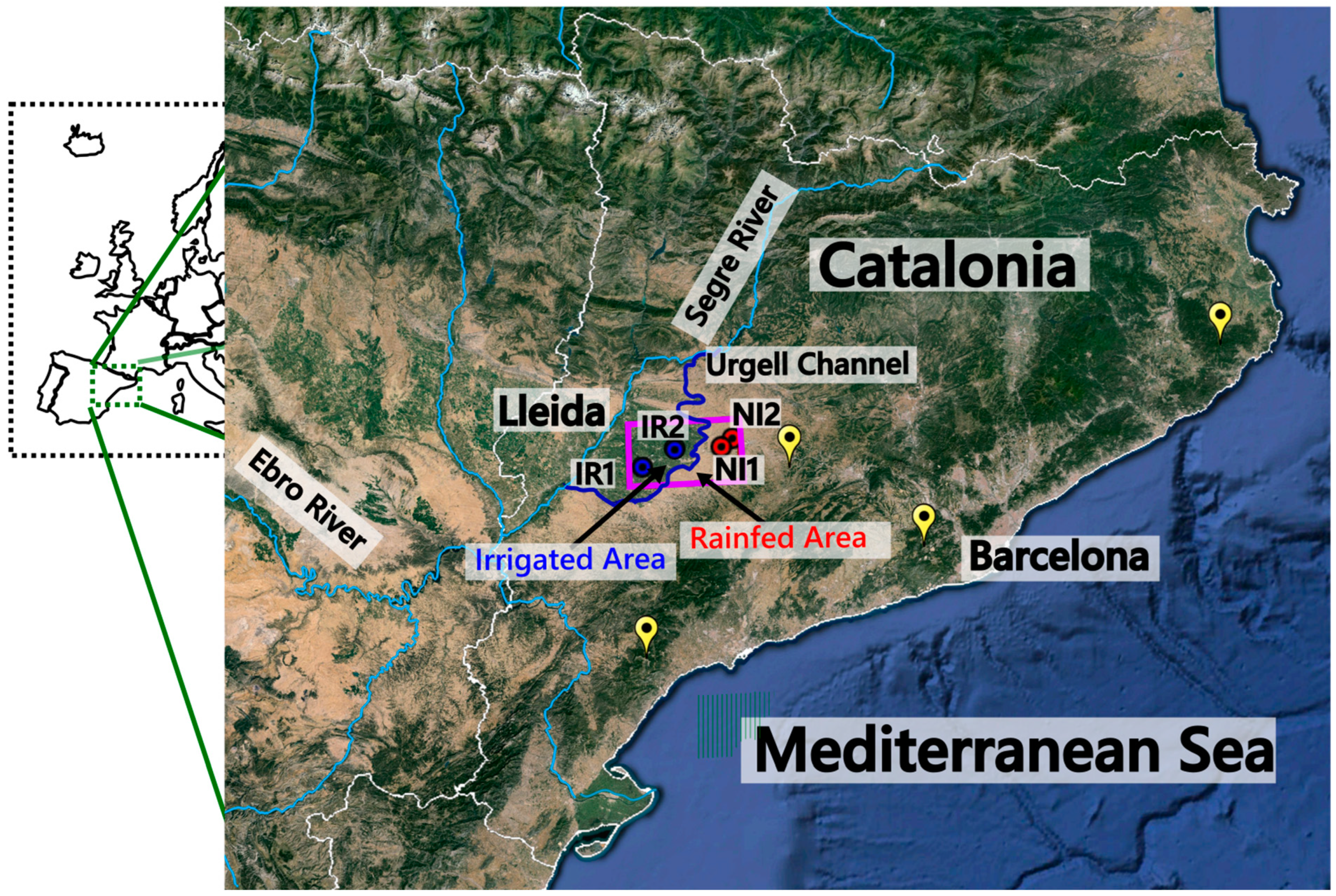
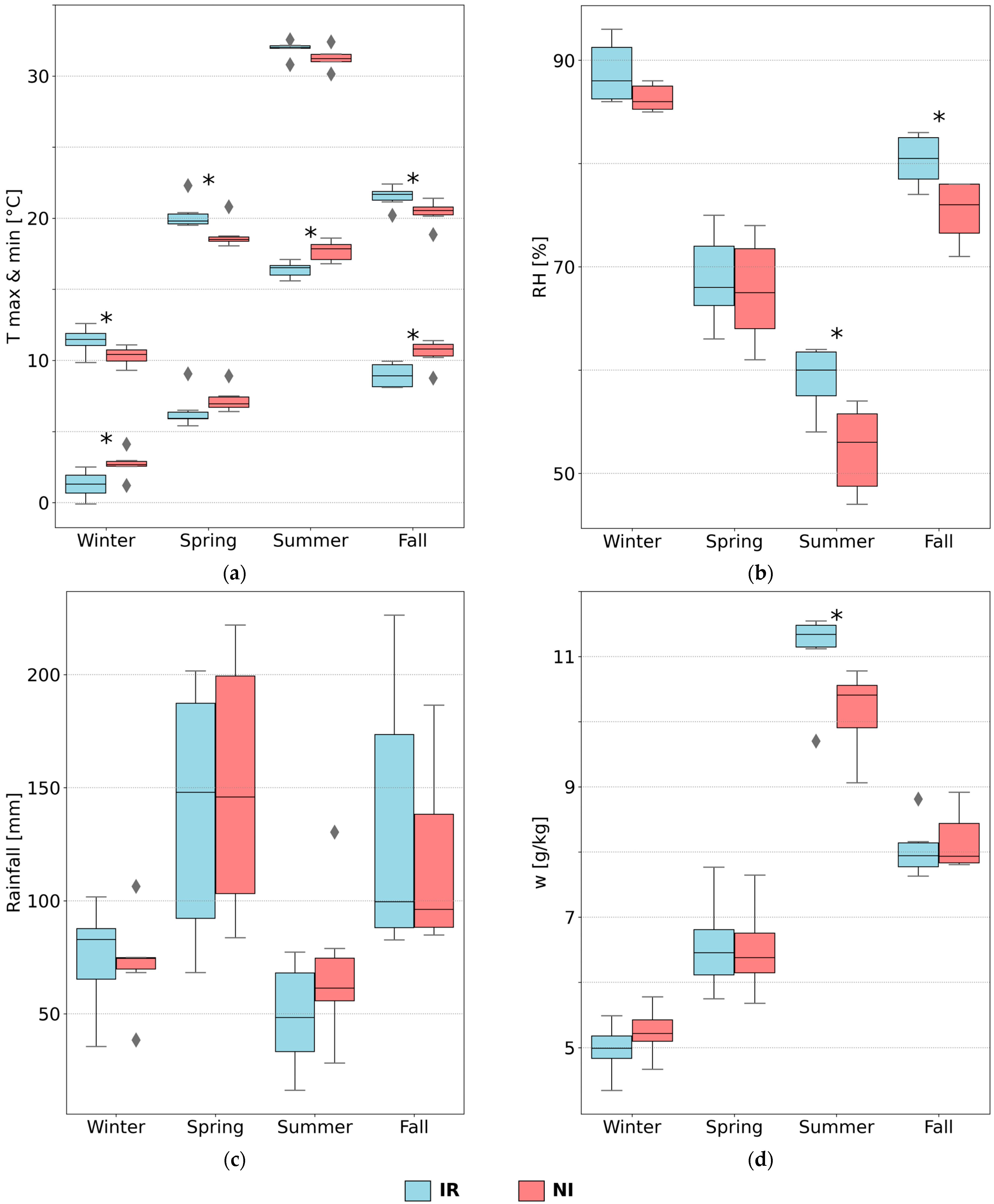
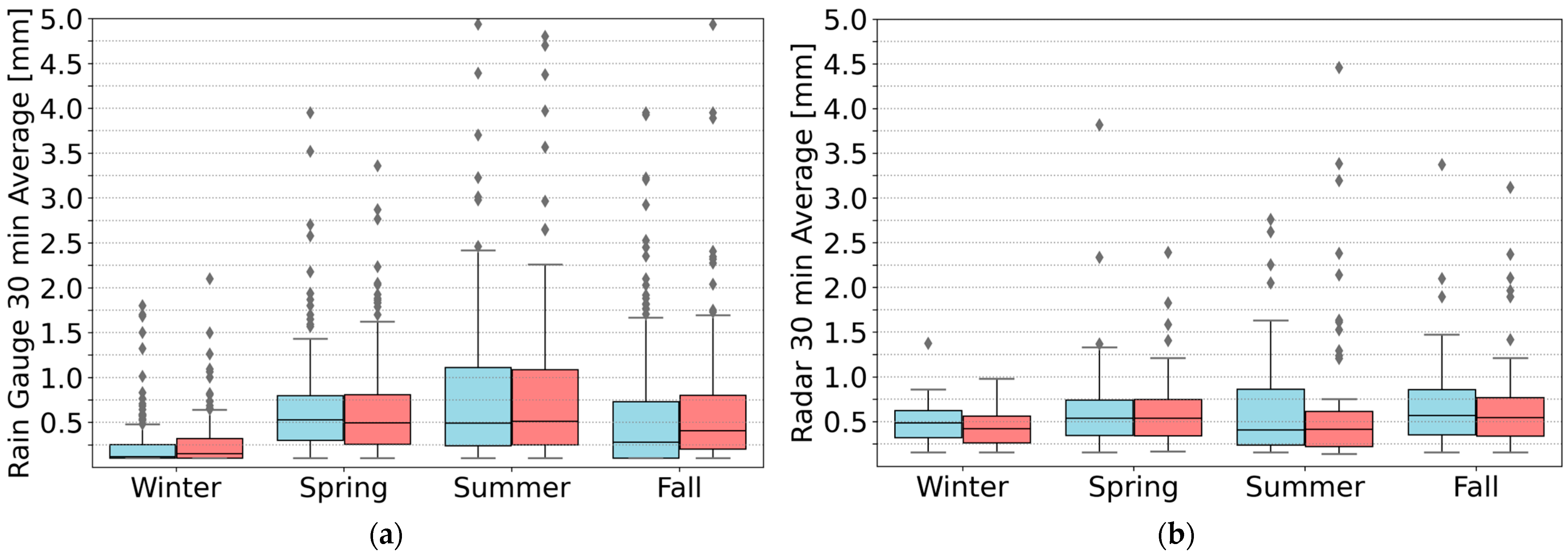
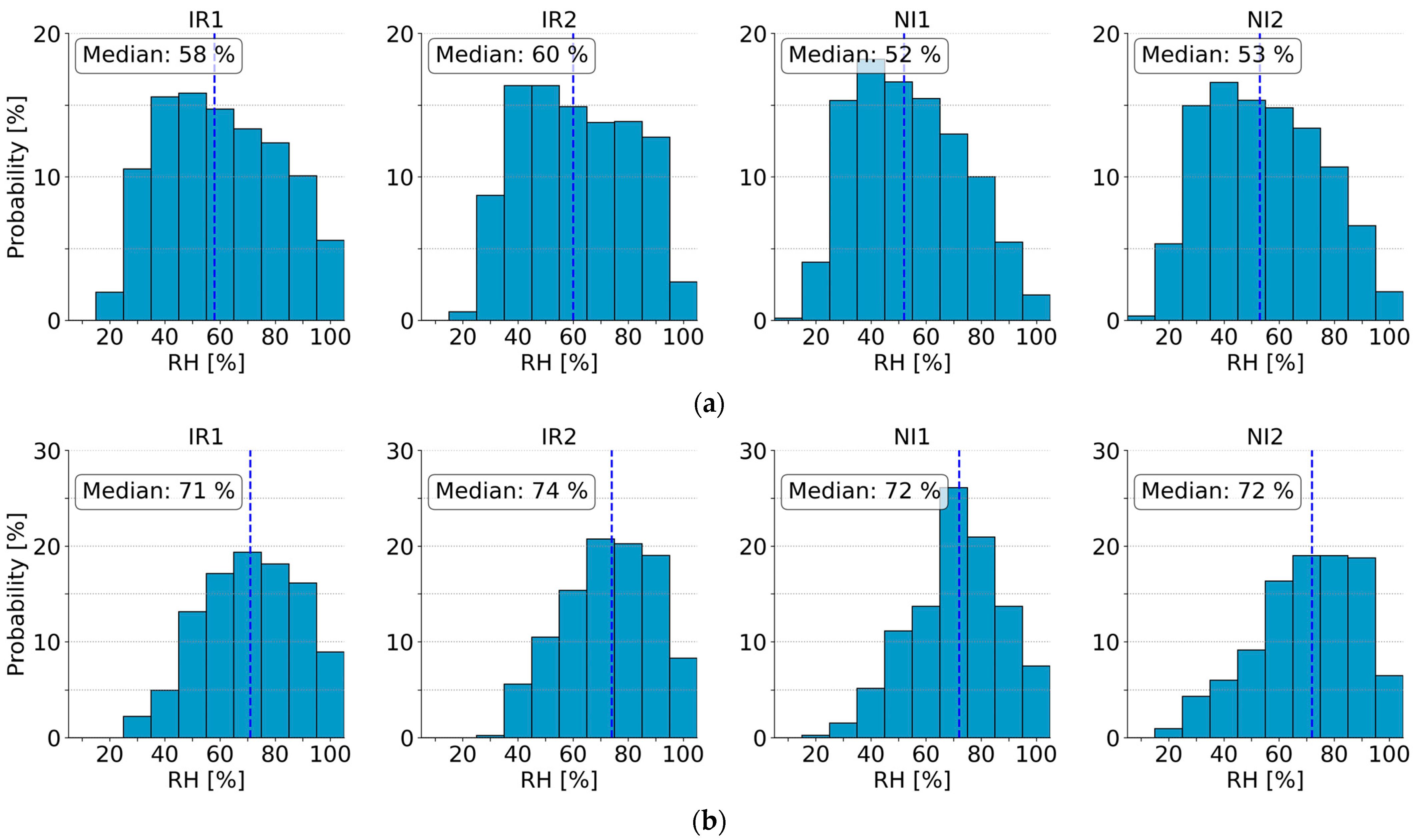
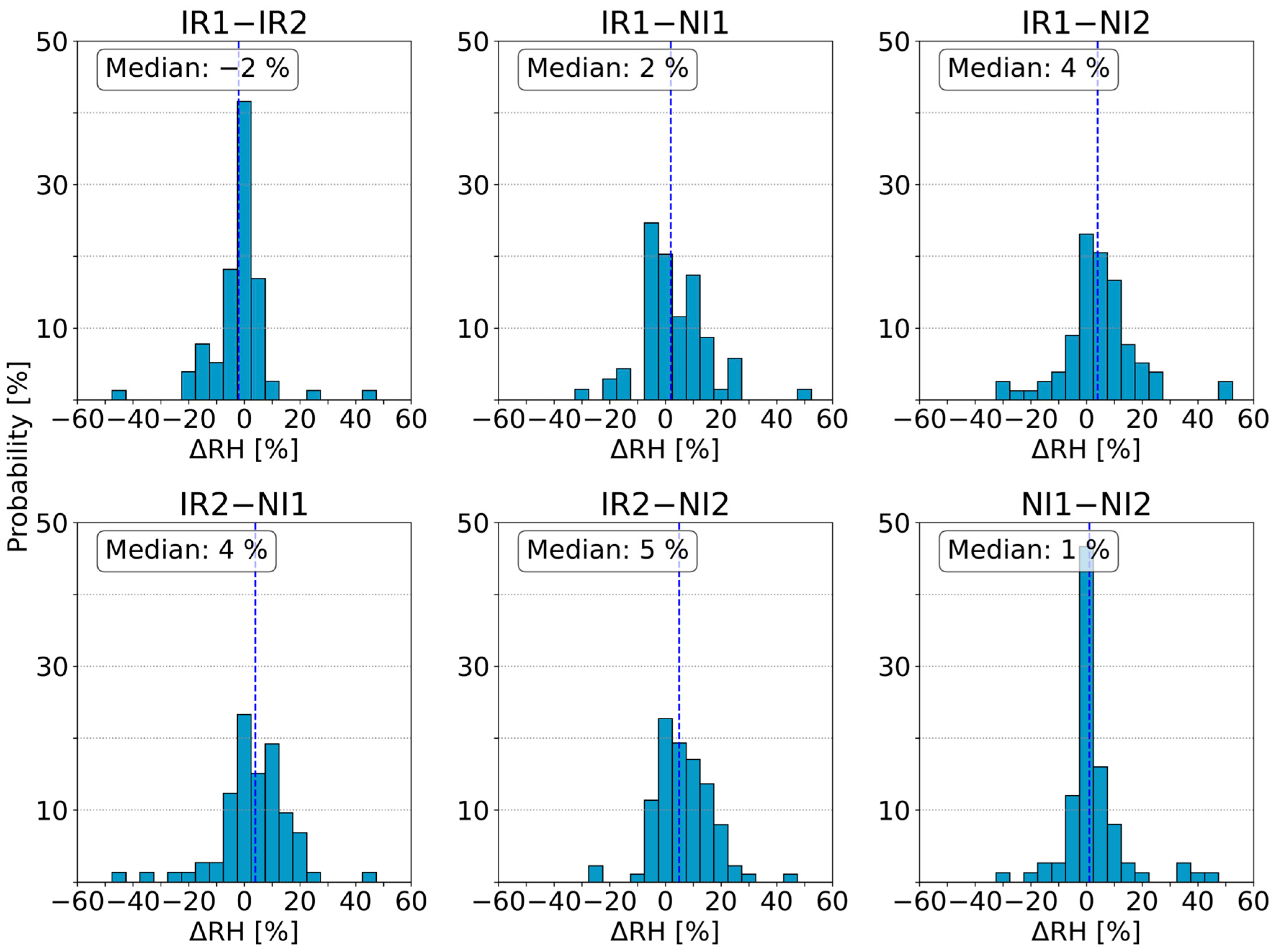
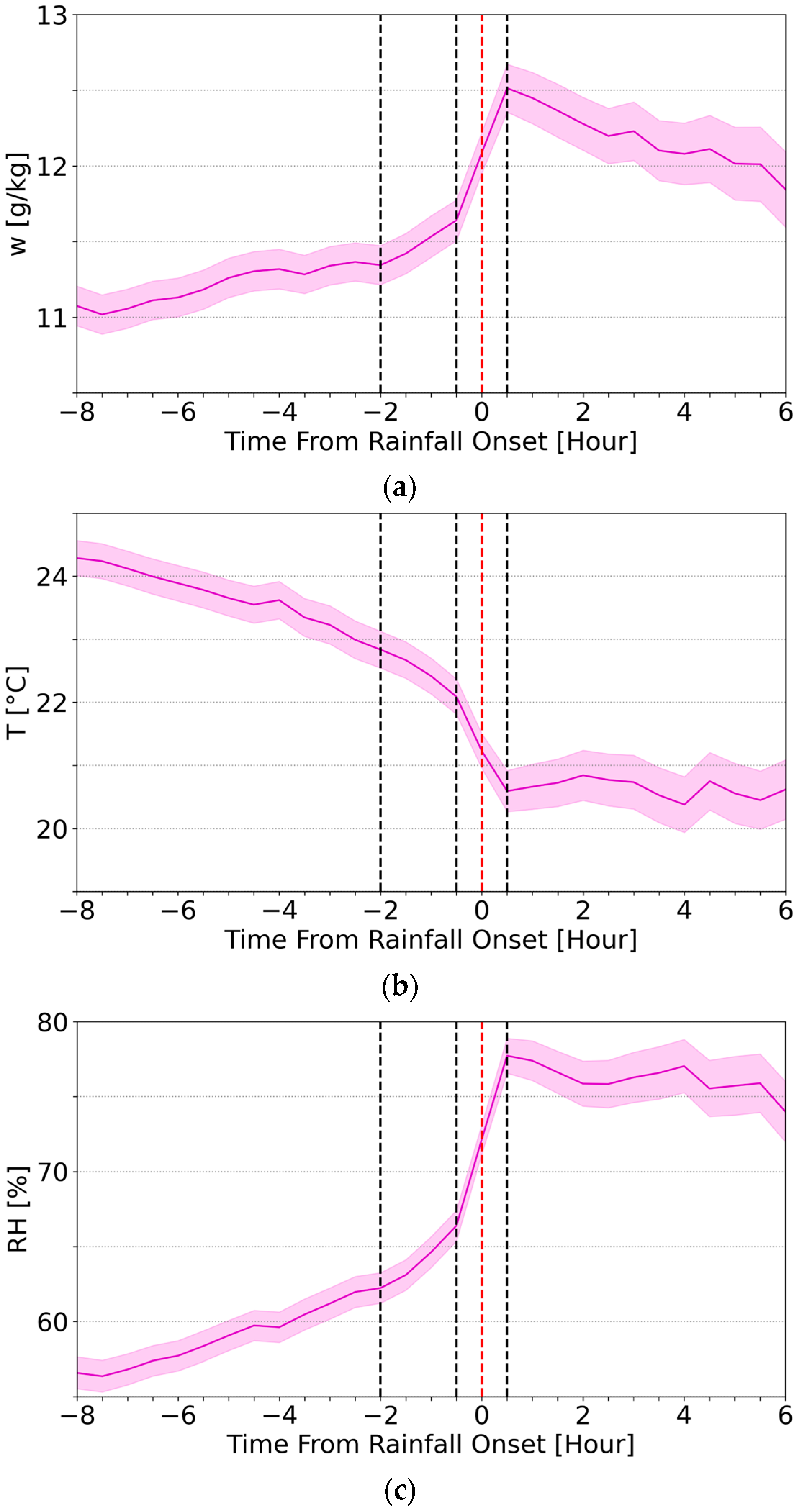
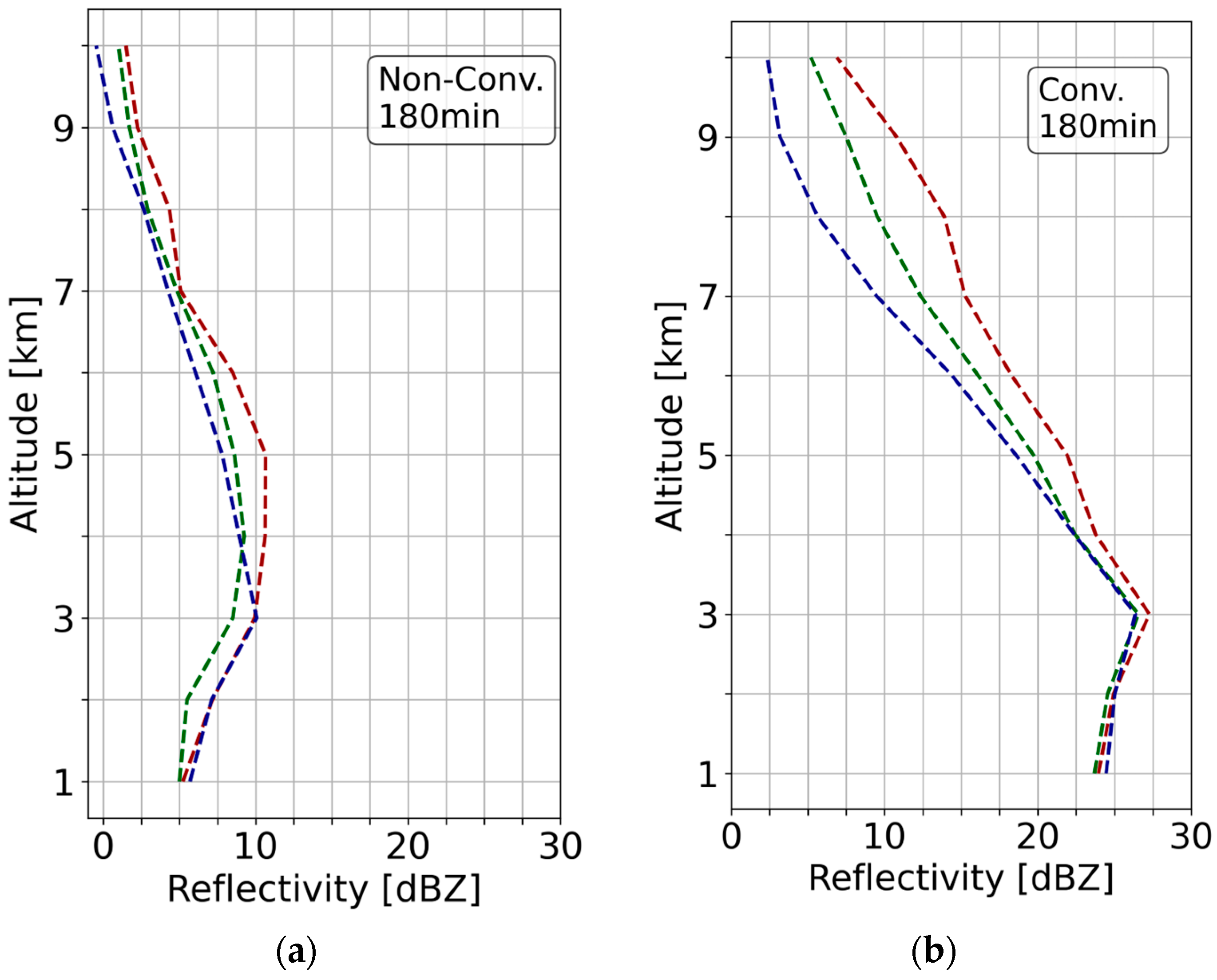
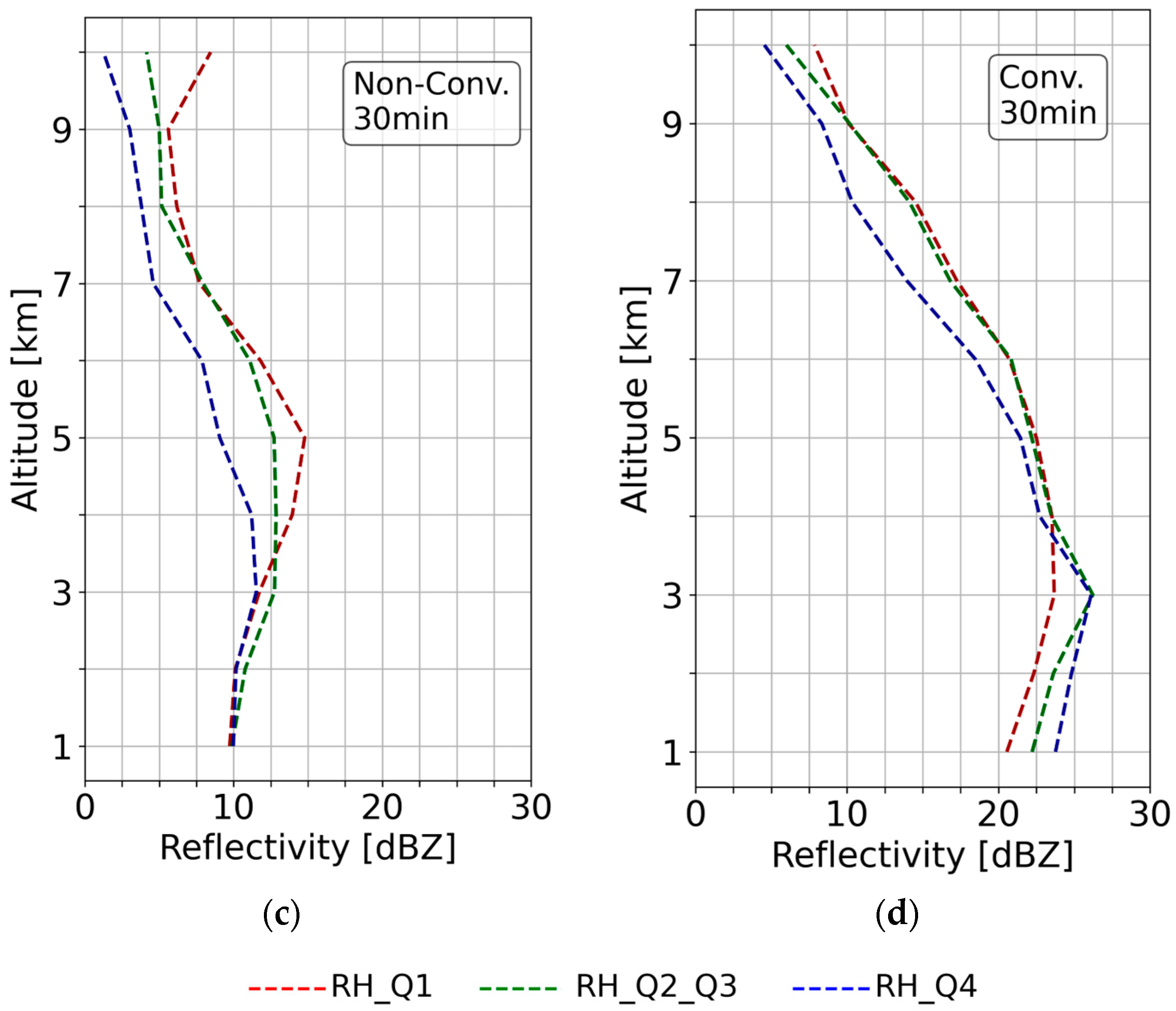
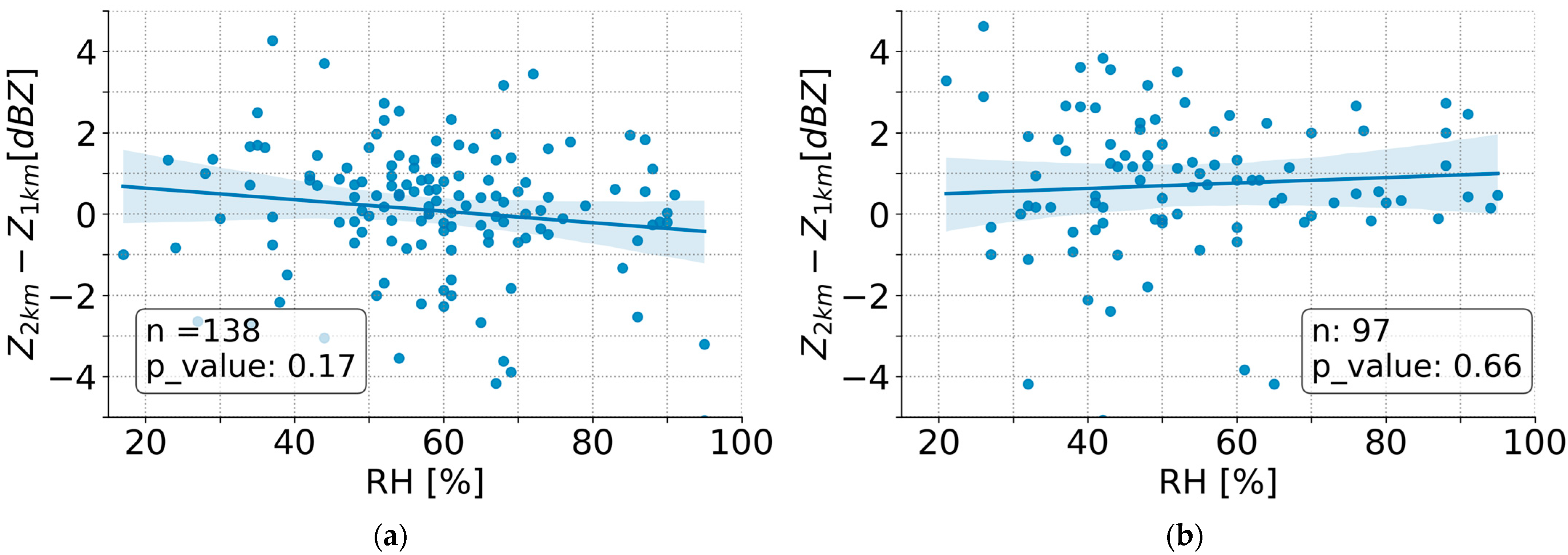
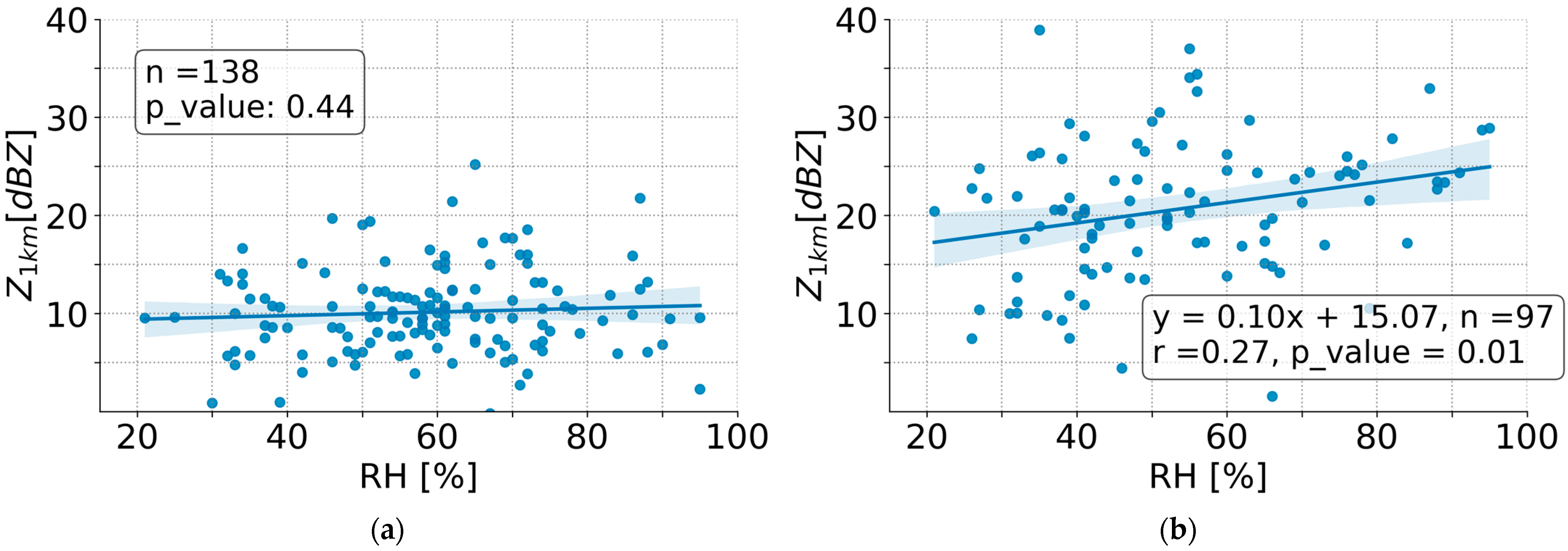
| AWS Rain Gauge Rainfall Data | Weather Radar Reflectivity Data |
|---|---|
|
|
Disclaimer/Publisher’s Note: The statements, opinions and data contained in all publications are solely those of the individual author(s) and contributor(s) and not of MDPI and/or the editor(s). MDPI and/or the editor(s) disclaim responsibility for any injury to people or property resulting from any ideas, methods, instructions or products referred to in the content. |
© 2025 by the authors. Licensee MDPI, Basel, Switzerland. This article is an open access article distributed under the terms and conditions of the Creative Commons Attribution (CC BY) license (https://creativecommons.org/licenses/by/4.0/).
Share and Cite
Polls, F.; Bech, J.; Udina, M.; Peinó, E.; Rigo, T. Local Influence of Surface Relative Humidity on Weather Radar Rainfall Observations over an Agricultural Semi-Arid Area. Remote Sens. 2025, 17, 439. https://doi.org/10.3390/rs17030439
Polls F, Bech J, Udina M, Peinó E, Rigo T. Local Influence of Surface Relative Humidity on Weather Radar Rainfall Observations over an Agricultural Semi-Arid Area. Remote Sensing. 2025; 17(3):439. https://doi.org/10.3390/rs17030439
Chicago/Turabian StylePolls, Francesc, Joan Bech, Mireia Udina, Eric Peinó, and Tomeu Rigo. 2025. "Local Influence of Surface Relative Humidity on Weather Radar Rainfall Observations over an Agricultural Semi-Arid Area" Remote Sensing 17, no. 3: 439. https://doi.org/10.3390/rs17030439
APA StylePolls, F., Bech, J., Udina, M., Peinó, E., & Rigo, T. (2025). Local Influence of Surface Relative Humidity on Weather Radar Rainfall Observations over an Agricultural Semi-Arid Area. Remote Sensing, 17(3), 439. https://doi.org/10.3390/rs17030439








